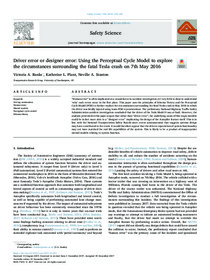Driver error or designer error: Using the Perceptual Cycle Model to explore the circumstances surrounding the fatal Tesla crash on 7th May 2016

Banks, Victoria A. ; Plant, Katherine L. ; Stanton, Neville A.
2018
108
Oct.
278-285
analysis of accident causes ; automation ; driver ; automobile industry
Technology
https://doi.org/10.1016/j.ssci.2017.12.023
English
Bibliogr.;Charts;Photos
"“Human error” is often implicated as a causal factor in accident investigation yet very little is done to understand ‘why' such errors occur in the first place. This paper uses the principles of Schema Theory and the Perceptual Cycle Model (PCM) to further explore the circumstances surrounding the fatal Tesla crash in May 2016 in which the driver was fatally injured using team-PCM representations. The preliminary National Highway Traffic Safety Administration accident investigation concluded that the driver of the Tesla Model S was at fault. However, the analysis presented in this paper argues that rather than “driver error”, the underlying cause of this tragic incident could be in fact more akin to a “designer error” implicating the design of the Autopilot feature itself. This is in line with the National Transportation Safety Boards more recent announcement that suggests systems design may have contributed to the crash. It would therefore appear that the drivers expectation of system functionality may not have matched the real life capabilities of the system. This is likely to be a product of inappropriate mental models relating to system function."
Digital
The ETUI is co-funded by the European Union. Views and opinions expressed are however those of the author(s) only and do not necessarily reflect those of the European Union or the ETUI.